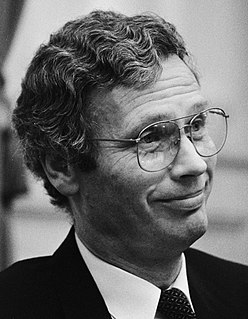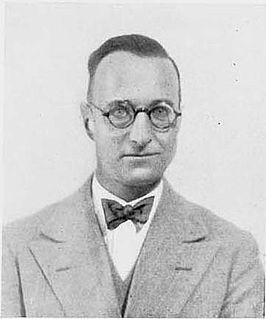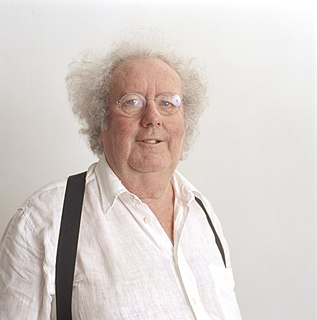
Rotterdam is the second largest city and municipality in the Netherlands. It is in the province of South Holland, at the mouth of the Nieuwe Maas channel leading into the Rhine–Meuse–Scheldt delta at the North Sea. Its history goes back to 1270, when a dam was constructed in the Rotte. In 1340, Rotterdam was granted city rights by William IV, Count of Holland. The Rotterdam–The Hague metropolitan area, with a population of approximately 2.7 million, is the 10th-largest in the European Union and the most populous in the country.
The year 1953 in architecture involved some significant events.

Henri "Hans" van den Broek is a retired Dutch politician and diplomat of the defunct Catholic People's Party (KVP) and later the Christian Democratic Appeal (CDA) party and jurist who served as European Commissioner from 6 January 1993 until 16 September 1999.

Interbau was a housing development, constructed as part of the 1957 International Building Exhibition in the Hansaviertel area of West Berlin. The overall plan was managed by Otto Bartning, and the urban design competition was won by Gerhard Jobst and Willy Kreuer, whose plans were later executed in a modified form.

Team 10 – just as often referred to as Team X or Team Ten – was a group of architects and other invited participants who assembled starting in July 1953 at the 9th Congress of the International Congresses of Modern Architecture (CIAM) and created a schism within CIAM by challenging its doctrinaire approach to urbanism.

Jacob Berend "Jaap" Bakema was a Dutch modernist architect, notable for design of public housing and involvement in the reconstruction of Rotterdam after the Second World War.

The Lijnbaan is the main shopping street of Rotterdam. It was opened in 1953, as the main pedestrian street in the new shopping district, after the old shopping district was completely destroyed during the bombing of Rotterdam by the German Luftwaffe. It was designed by the firm Van den Broek & Bakema led by architects Jo van den Broek and Jacob B. Bakema. It was the first purpose-built pedestrian street in Europe.

Leendert Cornelis van der Vlugt was a Dutch architect in Rotterdam. In the architects office Brinkman & Van der Vlugt he was responsible for the architecture of the Van Nelle Factory, a listed monument of the UNESCO World Heritage Site since 2014.
Živko Popovski was the most prominent Macedonian architect after the Second World War. He was a professor at the Architectural Faculty in Skopje. He worked with Dutch architects and CIAM alumni Jo_van_den_Broek and Jaap Bakema. His most famous works are the Skopje Shopping Center (GTC), Pensioner's Home in Ohrid, and the reconstructed Culture Center "Grigor Prlichev" in Ohrid.

Structuralism is a movement in architecture and urban planning that evolved around the middle of the 20th century. It was a reaction to Rationalism's (CIAM-Functionalism) perceived lifeless expression of urban planning that ignored the identity of the inhabitants and urban forms.

The Faculty of Architecture and the Built Environment at TU Delft is the largest faculty of TU Delft with around 2,900 students. It is also one of the top faculties in the world: it was ranked 2nd in the world's top universities for architecture & built environment in the QS World University Rankings by Subject 2020, following the Massachusetts Institute of Technology (MIT), and 3rd in 2015, 2017 and 2018 an 2019.

The former Van Nelle Factory on the Schie in Rotterdam, is considered a prime example of the International Style based upon constructivist architecture. It has been a designated UNESCO World Heritage Site since 2014. Soon after it was built, prominent architects described the factory as "the most beautiful spectacle of the modern age" and "a poem in steel and glass".

Spangen is a neighborhood of Rotterdam, Netherlands.

Johannes Andreas Brinkman, also known as Jan Brinkman, was a Dutch architect and exponent of Nieuwe Bouwen, modern architecture in the Netherlands.
Benthem Crouwel Architects is a Dutch architectural firm founded in 1979 by Jan Benthem and Mels Crouwel. Today, partners Pascal Cornips, Daniel Jongtien, Saartje van der Made and Joost Vos lead an international team of 60 professionals at the Amsterdam based Benthem Crouwel LAB. They work on projects from Amsterdam, Paris and California.
Soejoedi Wirjoatmodjo was an architect in Indonesia who was active during the late 1960s and mid 1970s. In 1964, he was asked by President Sukarno to be in charge as chief architect for national architectural projects in the Jakarta. Soejoedi is considered to be the first native architect of the Post-Colonial period that is considered as a proponent of modernist architects and designers.

Michiel Brinkman (1873–1925) was a Dutch architect and the father of Johannes Brinkman the exponent of Nieuwe Bouwen, modern architecture in the Netherlands. Michiel Brinkman is notable for his Justus van Effen housing block complex in Spangen, which is a Rijksmonument, built in 1922. it incorporates 3m wide connecting terraces on the third floor, known in Dutch as Bovenstraten, and in English as 'Streets in the sky'.

Het Nieuwe Instituut is a cultural centre in Rotterdam, the Netherlands. It focuses on architecture, design, and digital culture. HNI is in a building designed by Jo Coenen at Museumpark 25 in the centre of Rotterdam, adjacent to the Museum Boijmans Van Beuningen. The building contains a shop, exhibition space, study centre, and archive, as well as the Sonneveld House, a pond, and a small park.

Moshé Zwarts was a Dutch architect, founder of the architectural office ZJA and a former senior professor of Architectural Technology at the Technical University of Delft and the Technical University of Eindhoven. His portfolio encompasses many infrastructural projects including football stadiums.

Plan for Skopje 1963 was the urban and architectural plan put forward to rebuild the city of Skopje following the 1963 Skopje earthquake. The plan was organised between 1963 and 1966 by the government of Yugoslavia and the United Nations. The rebuilding of the city attracted large international attention, this led to the involvement of a large number of high profile architects. The UN invited Kenzo Tange and his team to participate in an international competition for the urban design of the city centre in 1965; as one of several Yugoslav and international architecture teams. Architects that participated in the plan include Greek architect Constantinos Doxiadis and Polish architect Adolf Ciborowski. Dutch architects Van den Broek and Jaap Bakema. Luigi Piccinato (Italy) and Maurice Rotival (USA). Yugoslav participants included Aleksandar Dordevik, Slavko Brezoski, Edvard Ravnikar, Radovan Miščević and Fedor Wenzler.

















